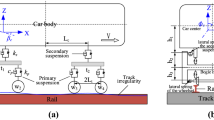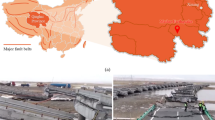Abstract
The prestressed-concrete continuous-girder bridge is one of the major high-speed railway bridges that plays an essential role in the railway. Using a typical high-speed railway continuous-girder bridge as a case study, a track-bridge longitudinal interaction model has been initially established with a comprehensive consideration of the components including rail, track slab, bed plate, rail fastener, cement asphalt mortar, sliding layer, and bridge structure. The damage states of the bridge and the seismic capacity model for key structural components of the bridge under various damages were defined. A probabilistic seismic demand model was constructed for structural components according to the incremental dynamic analysis of a suite of selected ground-motion. The fragility curves of the bridge components were derived and compared with that of the bridge model without a track system. Then, the failure probability of the bridge system was estimated using the first-order boundary method. Finally, the risk of the bridge was assessed via the numerical convolution method using both the fragility curves and seismic hazard function. The results are drawn as follows: (1) Owing to the longitudinal constraint of the track system, the dynamic characteristics of the bridge are changed; (2) A total of four damage levels occurred on the bridge pier without the track system, but only light and moderate damage levels appear due to the track constraint; (3) Under the same peak ground acceleration, the damage exceeding probability of the model without the track system is significantly greater than that with the track system; (4) Under the slight and moderate damage states, the upper and lower limits of the system fragility curves are governed by bridge pier. They are governed by the bearing with very low failure probability under the extensive and complete damage states; and (5) Within the 100-year design period, the probability that the bridge structure subject to slight and moderate damages is “occasional”, while it is “very unlikely” that the structure will suffer from the extensive and complete damages.
























Similar content being viewed by others
References
Agrawal AK, Tan P, Nagarajaiah S, Zhang J (2009) Benchmark structural control problem for a seismically excited highway bridge—Part I: Phase I problem definition. Struct Contr Health Monit 16(5):509–529
ATC/MCEER (2003) Recommended LRFD guidelines for the seismic design of highway bridges, Part I: Specifications. MCEER/ATC-49. Applied Technology Council and Multidisciplinary Center for Earthquake Engineering Research Center
California Department of Transportation (2009) Seismic design criteria. Version 1.5. California, USA
CCCC Highway Consultants CO., Ltd. (2007) Design criterion for road bridge culvert base foundation. JTG D63-2007, Beijing, China
Chen L, Li JZ (2011) Optimal selection of ground motion intensity measures for probabilistic seismic demand analysis of long-span bridge structures. J Vib Shock 30(10):91–97
Chen H, Hou S, Liang A (1993) Probabilistic level of fortification against earthquake and probabilistic models of seismic actions for hydraulic projects. J Nat Disasters 2:91–98 (in Chinese)
Choi E, Desroches R, Nielson B (2004) Seismic fragility of typical bridges in moderate seismic zones. Eng Struct 26(2):187–199
Cornell CA, Jalayer F, Hamburger RO, Foutch DA DA (2002) Probabilistic basis for 2000 SAC federal emergency management agency steel moment frame guidelines. J Struct Eng 128(4):526–533
Eskesen SD, Tengborg P, Kampmann J, Veicherts TH (2004) Guidelines for tunnelling risk management: International Tunnelling Association. Working group no. 2. Tunnel Undergr Space Technol 19(3):217–237
FEMA (2000) Recommended seismic design criteria for new steel moment frame buildings. Rep. No. FEMA-350, SAC Joint Venture, Federal Emergency Management Agency, Washington, DC
FEMA (2003) Multi-hazard loss estimation methodology, earthquake model. Federal Emergency Management Agency, Washington, DC
Gavali P, Shah MS, Kadam G, Meher K (2013) Seismic response and simulations of reinforced concrete bridge using opensees on high performance computing. CSI Trans ICT 1(3):215–220
Hwang HM, Liu JB, Chiu Y-H (2001) Seismic fragility analysis of highway bridges. MAEC Rep. 01-06, Center for Earthquake Research and Information, Univ. of Memphis, Memphis, TN
Kothalkar SG, Kadam SB (2016) Seismic vulnerability assessment of an existing railway bridge. J Civ Eng Environ Technol 3(6):553–557
Li LF, Wu WP, Huang JM, Wang LH (2011) Study on system vulnerability of medium span reinforced concrete continuous girder bridge under earthquake excitation. China Civ Eng J 45(10):152–160 (in Chinese)
Lu X, Lu XZ, Ye LP (2012) Discussion on the ground motion intensity measures for super high-rise buildings. China Civ Eng J 45(S1):292–296
Luo X (2017) Elastic-plastic time-history analysis of bridge seismic based on Opensees and IDA. In: International conference on mechanics, materials and structural engineering
Ministry of Housing and Urban-Rural Development of the People’s Republic of China (2006) Code for seismic design of railway engineering. GB50111-2006, Beijing, China
Ministry of Railways of the People’s Republic of China (2012) Code for design of railway continuous welded rail. TB10015-2012, Beijing, China
Ministry of Transport of the People’s Republic of China (2009) Spherical bearings for bridges. GB/T 17955-2009, Beijing, China
Nielson BG, DesRoches R (2007) Seismic fragility methodology for highway bridges using a component level approach. Earthq Eng Struct Dyn 36(6):823–839
Padgett JE, Nielson BG, Desroches R (2008) Selection of optional intensity measures in probabilistic seismic demand models of highway bridge portfolios. Earthq Eng Struct Dyn 37(5):711–725
Park F, Choi E (2011) Fragility analysis of track-on steel-plate-girder railway bridges in Korea. Eng Struct 33(3):696–705
Ramanathan K, DesRoches R, Padgett JE (2010) Analytical fragility curves for multispan continuous steel girder bridges in moderate seismic zones. Transportation Research Record 2202, Transportation Research Board, Washington, DC, pp 173–182
Ren JJ (2009) Research on force characteristics and structural optimization for longitudinal coupled ballastless track. PhD dissertation, Southwest Jiaotong University, Chengdu (in Chinese)
Sadrossadat-Zadeh M, Saiidi M (2007) Analytical study of NEESR-SG 4-span bridge model using OpenSees. Center for Civil Engineering Earthquake Research, Dept. of Civil Engineering, University of Nevada, Reno, Nevada, Report No. CCEER-07-03, January
Scott BD, Park R, Priestley MJN (1982) Stress-strain behavior of concrete Confined by Overlapping hoops at low and high strain rates. ACI J 79(1):13–27
Stewart JP, Chiou SJ, Bray JD, Somerville PG, Graves RW, Abrahamson NA (2001) Ground motion evaluation procedures for performance-based design. Berkeley California: Pacific Earthquake Engineering Research Centre. Report No. PEER-2001/09
Tavares D, Suescun JR, Paultre P, Padgett JE (2013) Seismic fragility of a highway bridge in Quebec. J Bridge Eng 18(11):1131–1139
Vamvatsikos D, Cornell CA (2002) Incremental dynamic analysis. Earthq Eng Struct Dyn 31(3):491–514
Vamvatsikos D, Cornell CA (2004) Applied incremental dynamic analysis. Earthq Spectra 20(2):491–514
Wang Y, Wang T, Tang Z (2014) Seismic fragility of cushioning high-speed railway bridges. Adv Transp Stud Int J 3(1):39–50
Xie X, Wang Y, Chen L (2012) Effect of rail restraints on seismic responses of cushioning railway bridges. J China Railw Soc 34(6):75–82 (in chinese)
Ye LP, Ma QL, Miu ZW (2009) Study on earthquake intensities for seismic analysis of structures. Earthq Eng Eng Vib 29(4):9–22
Acknowledgements
We acknowledge the National Natural Science Foundation of China (under Grant Nos. 51678492 and 51308471), the Doctoral Innovation Fund Program of Southwest Jiaotong University and the Sichuan Province Science and Technology Project (under Grant No. 2018FZ0095) for the support of this research.
Author information
Authors and Affiliations
Corresponding author
Rights and permissions
About this article
Cite this article
Cui, S., Guo, C., Su, J. et al. Seismic fragility and risk assessment of high-speed railway continuous-girder bridge under track constraint effect. Bull Earthquake Eng 17, 1639–1665 (2019). https://doi.org/10.1007/s10518-018-0491-9
Received:
Accepted:
Published:
Issue Date:
DOI: https://doi.org/10.1007/s10518-018-0491-9




